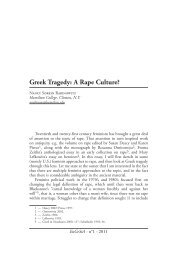Perspectives On and Of Livy's Tarpeia - EuGeStA
Perspectives On and Of Livy's Tarpeia - EuGeStA
Perspectives On and Of Livy's Tarpeia - EuGeStA
Create successful ePaper yourself
Turn your PDF publications into a flip-book with our unique Google optimized e-Paper software.
170 TaRa WeLCh<br />
perspectives not always able to be reconciled to each other. horatia’s story<br />
offers a particularly rich point of comparison, for there the outcome is<br />
much more comfortable. In contrast to <strong>Tarpeia</strong>’s story, in which no one is<br />
heroic, horatia’s story is full of commendable behaviors.<br />
In both episodes, Livy exploits the language of seeing <strong>and</strong> seeming so<br />
as to frame the latent questions about identity that these foundational<br />
stories explore in terms of vision <strong>and</strong> perspective. Unfortunately, the distance<br />
of time <strong>and</strong> the panoramic view Livy offers in his first book do not<br />
help the reader of either tale come to a firm conclusion about the moral<br />
lessons these stories offer. Rather, like the actors within the stories, we are<br />
faced with a fragmented <strong>and</strong> fragmentary picture that makes it difficult<br />
for us to label as good/imitable or bad/inimitable. What Livy’s readers can<br />
have that Livy’s characters lack is the realization that their own perspective<br />
is partial <strong>and</strong> that they are studying a process of assimilation as much as<br />
an outcome. <strong>and</strong> this is the conclusion one takes from Livy’s narrative<br />
of the Roman traitoress: more than a character in Roman myth, she is a<br />
process personified.<br />
Between History <strong>and</strong> Historiography:<br />
The Exemplum <strong>and</strong> its Requirements<br />
Livy’s famous preface announces that history is a useful moral tool:<br />
hoc illud est praecipue in cognitione rerum salubre ac frugiferum,<br />
omnis te exempli documenta in inlustri posita monumento intueri; inde<br />
tibi tuaeque rei publicae quod imitere capias, inde foedum inceptu foedum<br />
exitu quod uites (praef. 10) 1 .<br />
In underst<strong>and</strong>ing (past) events, this especially is salutary <strong>and</strong> beneficial:<br />
that you can see records of every sort of example set on display<br />
in this illustrious monument, from which you can take for yourself <strong>and</strong><br />
your country both that which you should imitate, <strong>and</strong> that which, being<br />
shameful from start to finish, you should avoid.<br />
This statement makes clear Livy’s goal of moral instruction, but this<br />
is no simple goal nor is it a simple statement of that goal 2 . The natural<br />
reading is to take this as a generalizing statement about history, but the<br />
words themselves give rise both to general <strong>and</strong> to more specific interpretations.<br />
Livy’s specific wording in this passage links history with historiography<br />
as partners in moral instruction, <strong>and</strong> draws in his audience not only<br />
1 — The text is Ogilvie’s Oxford edition (1974).<br />
2 — Ogilvie 1965 ad loc. notes the ease of underst<strong>and</strong>ing the general sense but the difficulty of<br />
locating the “precise force of these words”.



